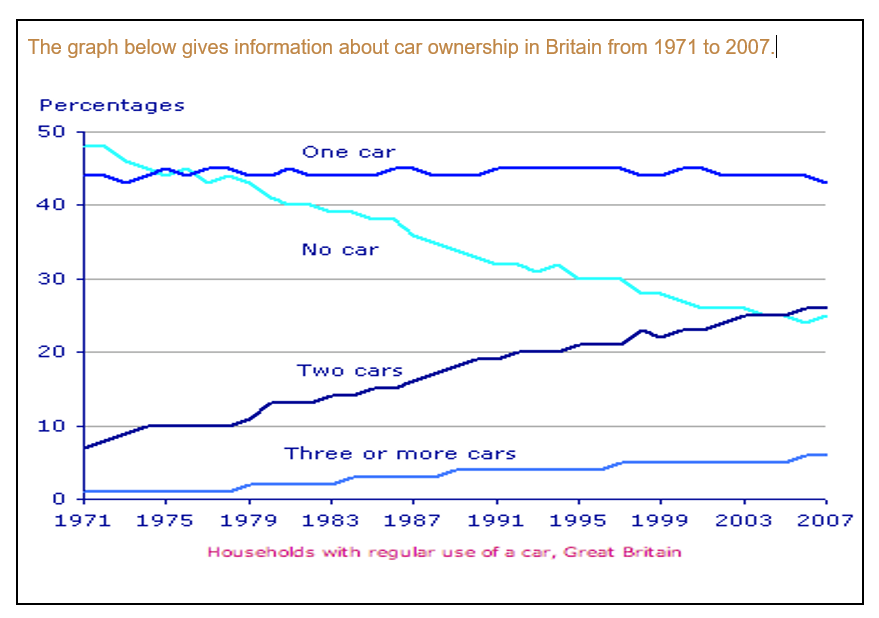Common questions for the line graph, bar graph, pie chart, and table
- Graph Type: Line Graph
- Title: Car Ownership in Britain from 1971 to 2007
- What are the units of measurement? (e.g., percentage, kilogrammes, the number of people or periods, amount, %, age, etc.) : Percentage of cars by year
- Who: (e.g. groups, such as three different countries or men or women): car ownership in Britain
- When: (Periods like Jan-Mar or 1999 to 2015): 1971 to 2007
- Where: (Place, e.g. Australia): Britain
- Topic: Households with regular use of the car (percentage) in Great Britain
Comparison Showing and Trends
Any change over time (such as an increase or a decrease) is a trend.
Comparison 1: car in 1971
Details:
- almost half of all British did not have a car
- about 44% had a car
- about 7% had two cars
- around 2% own three or more cars
Comparison 2: changes from 1971 to 2007
Details:
- one-car households were common in the 1970s, and little changes over the period
- Biggest changes in without a car to over 36-year period 25% in 2007
- Two-car family rose steadily, reaching 26% in 2007
- three or more car ownership rose by almost 5%
Sample Answer 1:
The graph shows changes in the number of cars by household in Great Britain over a period of 36 years.
Overall, car ownership in Britain increased between 1971 to 2007. In particular, the number of households with two cars rose, while the number of households with a car fell.
Looking into the details, in 1971, over half of all British households did not have regular use of a car. Around 44% of households had one car, but only about 7% had two cars. It was uncommon for families to own three or more cars, with only around 2% of households falling into this category.
The one-car household was the most common type from the late 1970s onwards, although the figures/percentage for this category remained the same. The biggest change was seen in the proportion of households without a car, which fell steadily over the 36 years to around 25% in 2007. In contrast, the proportion of two-car families rose readily, reaching about 26% in 2007, and the proportion of households with more than two cars rose to around 5%.
Sample Answer 2:
The provided graph illustrates the changeability in car ownership per household in Great Britain over a span of 36 years, from 1971 to 2007.
Overall, there was a substantial increase in car ownership during this period, with a notable rise in households possessing two cars, while the number of households without any cars declined.
What can be seen from the graph is that in 1971, approximately half of all British households did not have regular access to a car. At that time, around 44% of households owned a single car, while merely 7% possessed two cars. The ownership of three or more cars was relatively uncommon, with a meagre 2% falling into this category.
From the late 1970s onward, one-car households emerged as the most prevalent type, despite observing minimal changes in its percentage. The most significant transformation occurred in the proportion of households without a car, which experienced a continuous decrease over the 36-year period, reaching approximately 25% in 2007. Conversely, the percentage of households with two cars demonstrated steady growth, reaching approximately 26% in 2007. Moreover, there was a modest increase in households with more than two cars, accounting for around 5%.
Here are some sentences from the sample answer that demonstrate effective language use:
- “Overall, car ownership in Britain increased between 1971 to 2007.”
- “The one-car household was the most common type from the late 1970s onwards.”
- “The biggest change was seen in the proportion of households without a car, which fell steadily over the 36-year period.”
- “In contrast, the proportion of two-car families rose readily, reaching about 26% in 2007.”
- “The graph shows changes in the number of cars by household in Great Britain over a period of 36 years.”
- These sentences provide clear and concise information about the overall trend, the most prevalent type of household, the significant change in households without cars, the rise in two-car families, and the context of the graph.
These sentences effectively convey information from the graph, using clear and concise language to describe the trends and figures. They clearly understand the data and effectively communicate the key points.
Here are alternative ways to write the five sentences:
- Overall, car ownership in Great Britain exhibited a consistent upward trend over the span of 36 years, from 1971 to 2007.
- Throughout the late 1970s and beyond, households with a single car were the most common type.
- Notably, there was a remarkable decline in the percentage of households without a car, steadily decreasing over the entire duration of the 36-year period.
- Conversely, there was a substantial increase in the proportion of households owning two cars, reaching approximately 26% by 2007.
- The graph visually portrays the fluctuation in the number of cars per household in Great Britain, offering insights into the changes that occurred over the specified timeframe.
Vocabularies: 10 Words
This table provides information about each word, including its type, meaning, pronunciation, root, related words, word family, synonyms, antonyms, and example sentences.
|
Word |
Type |
Meaning |
Pronunciation |
Root |
Related Words |
Word Family |
Synonyms |
Antonyms |
Examples |
|
Changeability |
Noun |
The state or quality of being capable of change |
ˌtʃeɪn(d)ʒəˈbɪləti |
Change |
Adaptability |
Changeable |
Flexibility |
Stability |
The changeability of weather makes it unpredictable. |
|
Substantial |
Adjective |
Considerable in importance, value, or amount |
səbˈstænʃ(ə)l |
Substance |
Significant |
Substantiate |
Considerable |
Insignificant |
The company made substantial profits this year. |
|
Notable |
Adjective |
Worthy of attention or notice |
ˈnəʊtəb(ə)l |
Note |
Remarkable |
Notably |
Remarkable |
Insignificant |
She has made notable contributions to the field. |
|
Decline |
Verb |
Decrease or become less |
dɪˈklaɪn |
Latin: declinare |
Decrease, reduction, |
Declination |
Decrease |
Increase |
The population of that species continues to decline. |
|
Access |
Noun |
The means or opportunity to approach or enter something |
ˈæksɛs |
Latin: accessus |
Entrance, |
Accessible |
Entrance |
Denial |
The building has wheelchair access. |
|
Meagre |
Adjective |
Lacking in quantity or quality, scanty |
ˈmiːɡə(r) |
Latin: macer |
Scant, sparse, |
Meagerness |
Scanty |
Abundant |
The family survives on a meagre income. |
|
Prevalent |
Adjective |
Widespread, commonly occurring, or existing |
ˈprɛvələnt |
Latin: praevalere |
Common, widespread, |
Prevalence |
Common |
Rare |
Obesity is prevalent in Western countries. |
|
Transformation |
Noun |
A thorough or dramatic change or conversion |
ˌtrænsfəˈmeɪʃ(ə)n |
Transform |
Change, conversion, |
Transformative |
Change |
Stagnation |
The transformation of the caterpillar into a butterfly. |
|
Continuous |
Adjective |
Forming an unbroken whole, without interruption |
kənˈtɪnjʊəs |
Continue |
Uninterrupted, |
Continuity |
Uninterrupted |
Discontinuous |
The rain was continuous throughout the day. |
|
Modest |
Adjective |
Unassuming or moderate in estimation or size |
ˈmɒdɪst |
Latin: modestus |
Humble, unpretentious, |
Modesty |
Humble |
Arrogant |
She gave a modest presentation about her achievements. |









